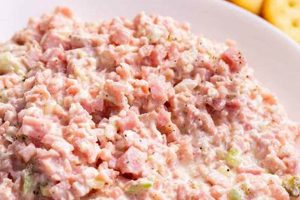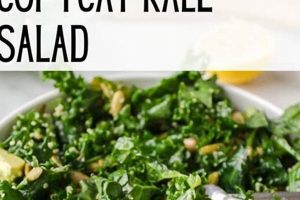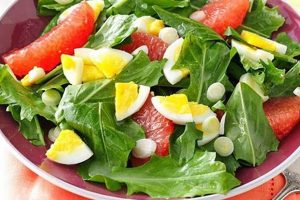Dishes featuring cooked or raw beet greens offer a nutritious and flavorful way to minimize food waste and maximize culinary enjoyment. These leafy greens, often discarded as a byproduct of beetroots, possess a slightly bitter, earthy taste similar to spinach or chard, and can be incorporated into various salads, sauts, and side dishes. A simple preparation might involve tossing blanched beet greens with a vinaigrette, toasted nuts, and crumbled cheese.
Utilizing the entire beet plant offers significant nutritional advantages. Beet greens are rich in vitamins A, C, and K, as well as minerals like potassium and iron. Historically, beet greens have been consumed across cultures for their health benefits, long before beetroot itself gained popularity. Their inclusion in meals provides a sustainable approach to cooking by reducing waste and maximizing the nutritional value derived from readily available ingredients.
This discussion will further explore the versatility of beet greens in salads, examining diverse flavor combinations and preparation techniques. Topics covered will include selecting, storing, and preparing fresh beet greens; complementary ingredients and dressings; and creative ways to integrate them into balanced, appealing meals.
Tips for Preparing Beet Green Salads
Successful preparation of beet green salads requires attention to detail to optimize both flavor and texture. The following tips offer guidance for creating delicious and visually appealing dishes.
Tip 1: Selecting Fresh Greens: Choose beet greens that appear vibrant and crisp, avoiding wilted or yellowed leaves. Smaller, younger leaves tend to offer a more tender texture and milder flavor.
Tip 2: Thorough Cleaning: Beet greens often retain soil and grit, necessitating thorough washing. Submerge the leaves in a basin of cold water and gently agitate to remove any debris. Repeat this process until the water runs clear.
Tip 3: Proper Storage: To maintain freshness, store unwashed beet greens in a perforated plastic bag in the refrigerator crisper drawer. Ideally, use them within two to three days of purchase.
Tip 4: Blanching for Optimal Texture: Briefly blanching the greens in boiling water helps to soften their texture and reduce bitterness. Plunge the leaves into boiling water for 30-60 seconds, then immediately transfer to an ice bath to stop the cooking process.
Tip 5: Balancing Flavors: The earthy flavor of beet greens pairs well with contrasting tastes. Consider incorporating acidic elements like citrus vinaigrette, creamy cheeses such as goat or feta, and crunchy textures from toasted nuts or seeds.
Tip 6: Creative Ingredient Combinations: Explore diverse flavor profiles by incorporating complementary ingredients. Roasted vegetables, dried fruits, or caramelized onions can add depth and complexity to beet green salads.
Tip 7: Dressing Application: Dress the salad just before serving to prevent the greens from becoming soggy. Lightly coat the leaves with the chosen dressing, ensuring even distribution.
By following these tips, one can create flavorful and visually appealing beet green salads that showcase the versatility and nutritional value of this often-overlooked ingredient.
These techniques provide a foundation for incorporating beet greens into a variety of culinary creations, from simple side dishes to elaborate composed salads.
1. Fresh Beet Greens
Fresh beet greens serve as the foundational ingredient in beet green salad recipes, impacting the final dish’s flavor, texture, and nutritional value. Understanding the characteristics and preparation of fresh beet greens is essential for creating successful and enjoyable salads.
- Sourcing and Selection
High-quality beet greens are crucial. Look for vibrant, crisp leaves without signs of wilting or yellowing. Smaller, younger leaves generally offer greater tenderness and a milder flavor. Farmers’ markets and local produce sections often provide the freshest options. Sourcing greens from reputable suppliers ensures optimal quality and flavor in the finished salad.
- Cleaning and Handling
Beet greens can retain soil and grit, necessitating thorough cleaning. Submerge leaves in cold water and gently agitate, repeating until the water runs clear. Handle the greens delicately to avoid bruising or tearing. Proper cleaning and gentle handling maintain the integrity of the leaves, contributing to a more appealing salad.
- Storage for Freshness
Proper storage maintains the quality of beet greens until use. Store unwashed greens in a perforated plastic bag within the refrigerator’s crisper drawer. Ideally, utilize them within two to three days of purchase. Correct storage preserves freshness and prevents premature wilting, ensuring optimal quality for salad preparation.
- Pre-Preparation Techniques
Blanching beet greens quickly in boiling water, followed by an immediate ice bath, reduces bitterness and enhances texture. This step also brightens the color, making the salad more visually appealing. Blanching contributes to a more palatable and aesthetically pleasing finished product.
The selection, handling, and pre-preparation of fresh beet greens directly influence the final quality of beet green salads. Attention to these details ensures a flavorful, visually appealing, and nutritionally rich dish.
2. Complementary Flavors
The inherent earthy, slightly bitter taste of beet greens necessitates careful consideration of complementary flavors to create balanced and palatable salads. Strategic pairings enhance the greens’ natural characteristics, resulting in a more complex and enjoyable culinary experience. The following facets illustrate effective flavor combinations within beet green salad recipes.
- Acidity
Acidity provides a crucial counterpoint to the earthiness of beet greens. Ingredients like lemon juice, vinegar, or other acidic components brighten the flavor profile and cut through any bitterness. A simple vinaigrette with lemon juice and olive oil, for example, offers a classic pairing. The incorporation of acidity elevates the overall taste, preventing the salad from becoming overly earthy or one-dimensional.
- Creaminess/Fat
Creamy elements, such as goat cheese, feta, or a light vinaigrette with avocado oil, temper the bitterness of beet greens and contribute a rich mouthfeel. These ingredients complement the greens’ texture while adding a layer of complexity. The creamy texture contrasts with the sometimes slightly rough texture of the greens, creating a more balanced and satisfying sensory experience.
- Sweetness
A touch of sweetness further balances the flavor profile. Incorporating ingredients like roasted beets, dried cranberries, or a drizzle of honey or maple syrup introduces a subtle sweetness that contrasts with the greens’ earthiness. This interplay of flavors creates a more nuanced and well-rounded salad.
- Crunchy Textures
Contrasting textures enhance the enjoyment of beet green salads. Toasted nuts, such as walnuts or pecans, or seeds like sunflower or pumpkin seeds, provide a satisfying crunch. This textural element adds interest and complements the softer texture of the greens. The interplay of textures elevates the overall dining experience.
Successfully incorporating complementary flavors elevates beet green salads from simple sides to complex and satisfying dishes. The interplay of acidity, creaminess, sweetness, and textural contrasts transforms the inherent earthiness of beet greens into a nuanced and enjoyable culinary experience. By thoughtfully combining these elements, one can craft salads that showcase the versatility and potential of this often-underutilized ingredient.
3. Balanced Textures
Textural diversity plays a crucial role in the overall enjoyment of beet green salad recipes. A combination of textures elevates the sensory experience beyond flavor alone, creating a more dynamic and satisfying dish. Balancing the inherent texture of beet greens with contrasting elements adds complexity and visual appeal. The following facets explore the importance of balanced textures in these salads.
- Tender Greens as a Foundation
Beet greens, whether raw or blanched, offer a naturally tender, leafy texture that serves as the foundation of the salad. This inherent tenderness provides a pleasant backdrop for incorporating other textural components. Blanching can further refine the texture, reducing any potential toughness in mature leaves and creating a more universally appealing base.
- Crunchy Elements for Contrast
Crunchy elements provide a stark contrast to the tenderness of beet greens. Toasted nuts, such as walnuts, pecans, or almonds, offer a robust crunch. Seeds, like sunflower or pumpkin seeds, contribute a lighter, crisper texture. These contrasting textures create a dynamic interplay that enhances the overall eating experience.
- Creamy Components for Richness
Creamy ingredients introduce a textural dimension that complements both the tender greens and crunchy elements. Crumbled cheeses like feta or goat cheese provide a smooth, creamy contrast. Avocado slices contribute a similar creaminess while adding a healthy fat component. These creamy textures add richness and depth to the salad.
- Other Textural Considerations
Additional textural variations can further enhance beet green salads. Roasted vegetables, such as diced sweet potatoes or roasted chickpeas, contribute a slightly firm, yet tender texture. Adding cooked grains, like quinoa or farro, introduces a chewy element. These additions create a multi-faceted textural experience that elevates the salad beyond a simple combination of greens and dressing.
The interplay of textures in beet green salads elevates these dishes from simple to sophisticated. Balancing the tender greens with crunchy, creamy, and other varied textures creates a more dynamic and satisfying sensory experience. Thoughtful consideration of textural elements elevates the enjoyment and overall appeal of beet green salads.
4. Proper Preparation
Proper preparation techniques are essential for maximizing the flavor, texture, and overall quality of beet green salad recipes. These techniques ensure that the beet greens are handled in a way that optimizes their inherent qualities and contributes to a more enjoyable culinary experience. From initial selection to final presentation, careful attention to detail significantly impacts the final dish.
- Cleaning and Trimming
Thorough cleaning removes soil and grit that often cling to beet greens. Submerging the leaves in cold water and gently agitating them, repeating the process until the water runs clear, is crucial. Trimming away any tough stems or damaged portions further enhances the salad’s texture and appearance. This initial step sets the stage for a more palatable and visually appealing final product.
- Blanching for Optimal Texture and Flavor
Blanching, a brief immersion in boiling water followed by an immediate ice bath, serves multiple purposes. It softens the texture of the greens, making them more tender, and reduces any inherent bitterness. Additionally, blanching brightens the color of the leaves, enhancing the salad’s visual appeal. This controlled cooking process optimizes the greens’ characteristics for incorporation into a variety of salad preparations.
- Drying and Handling
After blanching, thorough drying is essential to prevent a soggy salad. Gently patting the leaves dry with a clean kitchen towel or using a salad spinner removes excess moisture. Careful handling throughout the preparation process, avoiding excessive squeezing or bruising, maintains the integrity of the leaves and contributes to a more visually appealing final presentation.
- Timing of Dressing Application
The timing of dressing application plays a critical role in the final texture of the salad. Adding the dressing just before serving prevents the leaves from becoming wilted or soggy. This ensures that the greens maintain their texture and the salad retains its freshness. Proper timing preserves the crispness of the greens and the overall quality of the dish.
Proper preparation techniques are integral to successful beet green salad recipes. These steps, from cleaning and blanching to careful handling and timely dressing application, ensure that the beet greens are treated in a manner that maximizes their flavor, texture, and overall contribution to the final dish. Attention to these details elevates the salad from a simple side to a more complex and enjoyable culinary creation.
5. Creative Variations
Creative variations within beet green salad recipes offer opportunities to expand beyond traditional preparations and explore the ingredient’s versatility. These variations enhance flavor profiles, introduce textural contrasts, and elevate beet green salads from simple sides to more complex and interesting dishes. Innovation within these recipes stems from incorporating diverse ingredients, experimenting with flavor combinations, and adapting techniques to create unique culinary experiences. For instance, incorporating roasted root vegetables, such as sweet potatoes or parsnips, adds sweetness and a contrasting texture. Similarly, the addition of dried fruits, like cranberries or apricots, introduces a chewy texture and a sweet-tart flavor dimension. Integrating cooked grains, such as quinoa or farro, adds a hearty element and expands the salad’s nutritional value.
The practical significance of creative variations lies in their ability to transform beet green salads into customizable and adaptable dishes suitable for various occasions and palates. These variations allow cooks to tailor recipes based on seasonal availability, dietary preferences, and desired flavor profiles. A summer variation might feature grilled peaches and a light vinaigrette, while a fall version could incorporate roasted butternut squash and toasted pecans. The adaptability facilitated by creative variations ensures that beet green salads remain interesting and relevant throughout the year, maximizing the utilization of this nutritious and versatile ingredient.
In summary, creative variations within beet green salad recipes elevate the dish beyond basic preparations, offering a platform for culinary exploration and personalized flavor experiences. These variations contribute to a more dynamic and engaging culinary landscape, encouraging experimentation and maximizing the potential of beet greens as a key ingredient in diverse and satisfying salads.
Frequently Asked Questions about Beet Green Salads
This section addresses common inquiries regarding the preparation and enjoyment of beet green salads, offering practical guidance for incorporating this nutritious and versatile ingredient into one’s culinary repertoire.
Question 1: Can beet greens be eaten raw?
While beet greens can be consumed raw, particularly younger, more tender leaves, they often possess a slightly bitter flavor. Blanching the greens briefly in boiling water significantly reduces this bitterness and is generally recommended for a more palatable salad.
Question 2: How should beet greens be stored?
Unwashed beet greens should be stored in a perforated plastic bag in the refrigerator’s crisper drawer. Ideally, they should be consumed within two to three days of purchase to maintain optimal freshness.
Question 3: What flavors pair well with beet greens?
The earthy flavor of beet greens complements a variety of ingredients, including acidic components like citrus or vinegar, creamy elements such as goat cheese or feta, crunchy textures like toasted nuts, and subtle sweetness from ingredients like roasted beets or dried fruits.
Question 4: How can one reduce the bitterness of beet greens?
Briefly blanching the greens in boiling water, followed by immediate immersion in an ice bath, effectively reduces bitterness while maintaining their vibrant color and nutritional value.
Question 5: Are beet greens nutritionally valuable?
Beet greens are a rich source of vitamins A, C, and K, as well as minerals like potassium and iron. Incorporating them into one’s diet provides a valuable nutritional boost.
Question 6: How can beet greens be incorporated beyond salads?
Beyond salads, beet greens can be sauted, added to soups, stews, or stir-fries, or used as a filling for savory pastries. Their versatility allows for diverse culinary applications.
Understanding the nuances of selecting, preparing, and incorporating beet greens into various dishes allows for a more informed and enjoyable culinary experience. The versatility and nutritional benefits of this often-overlooked ingredient make it a valuable addition to any kitchen.
Further exploration of specific beet green salad recipes will provide practical examples of how to incorporate these techniques and create delicious and nutritious meals.
Beet Green Salad Recipes
Exploration of beet green salad recipes reveals the significant culinary potential of this often-discarded ingredient. From proper selection and preparation techniques to complementary flavor pairings and textural considerations, optimizing the use of beet greens in salads requires a nuanced understanding of their characteristics. The discussion highlighted the importance of balancing the greens’ inherent earthiness with contrasting flavors, such as acidity from citrus or vinegar, creaminess from cheese or avocado, and subtle sweetness from roasted vegetables or dried fruits. Furthermore, incorporating textural variety through crunchy nuts, seeds, or other vegetables elevates the sensory experience of these salads. Proper cleaning, blanching, and handling techniques ensure optimal flavor and texture, while creative variations allow for personalized and adaptable recipes.
The versatility and nutritional richness of beet greens present a compelling argument for their increased utilization in culinary practices. Minimizing food waste and maximizing nutritional intake through creative and flavorful preparations contributes to a more sustainable and health-conscious approach to cooking. Continued exploration of beet green salad recipes promises further culinary innovation and a deeper appreciation for the potential of this readily available and often-overlooked ingredient.






